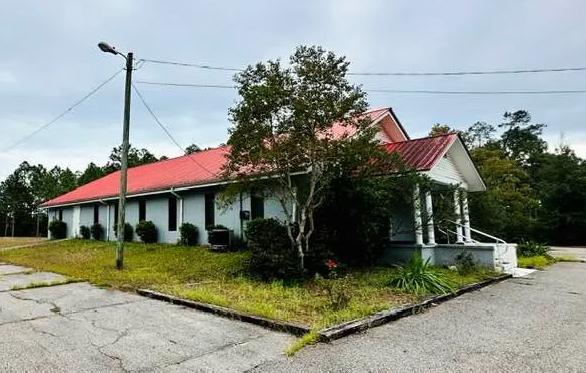Alliant offers to operate proposed REH
The future of health care in Franklin County is increasingly filling up the plate of the county commission.
A proposal introduced last month by the company that has run Weems Memorial Hospital for several years, asks that they be able to operate a new structure as a Rural Emergency Hospital should the county and Weems opt to go with that newly-introduced federal and state designation.
Michael Kozar, president and CEO of Alliant Rural Hospital Solutions, presented a report at the April 16 meeting, that outlined details of a possible REH, a designation that if adopted would end Weems’ status as a critical access hospital with inpatient services and replace it with a stand-alone emergency room with expanded outpatient capabilities.
Alliant’s proposal comes a month after Port St. Joe resident Dr. Huy Nguyen, an emergency room physician active with hospital management in Bonifay and Defuniak Springs, came to the commission to propose having a physician group buy Weems and convert it to a REH.
In a 15-page report, Kozar said the REH designation would translate to a roughly $276,000 per month subsidy from Medicare, or about $3.3 million annually, on the condition Weems end its inpatient, swing bed and drug reimbursement programs.
Kozar said Weems would meet the eligibility criteria for converting to a REH because it is in a rural area and licensed as a critical access hospital, is a licensed Medicare provider, has a transfer agreement with a trauma center and meets other staff training, average length-of-stay and state licensure requirements.
Were it to become an REH, Weems would offer round-the-clock and fully staffed emergency and observation services with an annual length-of-stay average of less than 24 hours, as well as diagnostic laboratory and radiology services, pharmacy drug storage and discharge planning supervised by qualified professionals.
Weems would have the option of providing ambulance services, behavioral health services, rural health clinic and primary care services, low-risk labor and delivery services, outpatient surgery, telehealth, care through a skilled nursing facility, post-hospital non-inpatient care and other outpatient medical and health services that do not exceed an annual per patient average length of stay of 24 hours.
“What needs to be determined is how many beds are set aside for observation,” Kozar said.
He declined to specify the effect on staffing levels. “That is something we have to take a look at,” Kozar said. “I can’t say until we get further along in this process. I don’t see a big effect.”
Kozar said conversion to an REH would take Weems’ net annual income out of the red, of a roughly $100,000 deficit, and bring it into positive territory of about $856,000 annually.
This would be largely due to the $3.3 million annual REH subsidy, minus the revenue of about $1 million annually from inpatient services, the loss of about $954,000 in state disproportionate share money, the loss of about $217,000 in drug subsidy money and the reduction in other outpatient service reimbursements.
Kozar asked the county consider striking a “use, operating and management” agreement with Alliant for a future REH. “This is not a panacea but it does put the provider with skin in the game,” he said. “You’ve got growth in this county but it’s a small county and it’s tough to survive in this size. We would negotiate with you keeping the facility, and we would tackle overall operations.
“I’m not prepared to share numbers with you, that is the cart before the horse,” Kozar said.
“We are not advocating for the sale of the hospital,” said Michael Stigler, a certified public advocate who serves as a director on the Alliant board. “All healthcare is local and decision making should stay local.”
Kozar ticked off success stories that Alliant has had at its facilities across the country, including in Chipley, where the hospital there went from five providers to 22.
Commission Chairman Ricky Jones voiced skepticism of Alliant’s proposal. “We had (Alliant) management for two or three years,” he said. “I’m not looking to extend the management. We want to do something significant with the hospital and move forward.”
The county commission is on the verge of selecting a healthcare consultant, from a field of three applicants, whose job will be to evaluate a future structure for Weems and review specifics of conversion to an REH.
“I want to get out of the hospital business,” said Commissioner Jessica Ward. “The health of our citizens is of utmost importance.
“We voted on this in 2008, and we told them we were going to build a new facility,” she said. “Right now I don’t think it (a full service hospital) is going to happen.”
In response to a question from Ward, Kozar said that while swing beds, which are reimbursable at a rate of $4,400 per day and are not allowed under an REH, skilled nursing beds could be placed at Weems, but they would be covered at about $500 to $600 a day.
Kozar noted a change in the law could affect whether Ascension Sacred Heart in Gulf County could become a critical access hospital, meaning it too would qualify for enhanced Medicare reimbursements. He said the mileage requirement that a hospital be further than 25 miles from the nearest facility to qualify, has been loosened to just 15 miles if the distance is just two-lane roads. “They (Ascension) technically would qualify for that,” he said.
Commissioner Ottice Amison expressed doubts that he would embrace Alliant’s proposal. “You guys have no risks in this as a management company,” he said. “We want to bring someone in that’s going to put something in it.
“We have not grown any and all,” Amison said, referring to Weems under Alliant’s tenure. “We need to move in this different direction and the only way this is going to get any better is if you feel it when it hurts.”
“After five years of managing the hospital, why now do you all want to come and ‘buy’ the hospital? How is this a good move for you guys?,” he asked. “You’ve seen the finances, what makes this an attractive thing to come and partner with us?
“What makes this lucrative to come in as a partnership?” Amison asked.
“We’re not sure yet,” answered Stigler.






Meet the Editor
David Adlerstein, The Apalachicola Times’ digital editor, started with the news outlet in January 2002 as a reporter.
Prior to then, David Adlerstein began as a newspaperman with a small Boston weekly, after graduating magna cum laude from Brandeis University in Waltham, Massachusetts. He later edited the weekly Bellville Times, and as business reporter for the daily Marion Star, both not far from his hometown of Columbus, Ohio.
In 1995, he moved to South Florida, and worked as a business reporter and editor of Medical Business newspaper. In Jan. 2002, he began with the Apalachicola Times, first as reporter and later as editor, and in Oct. 2020, also began editing the Port St. Joe Star.